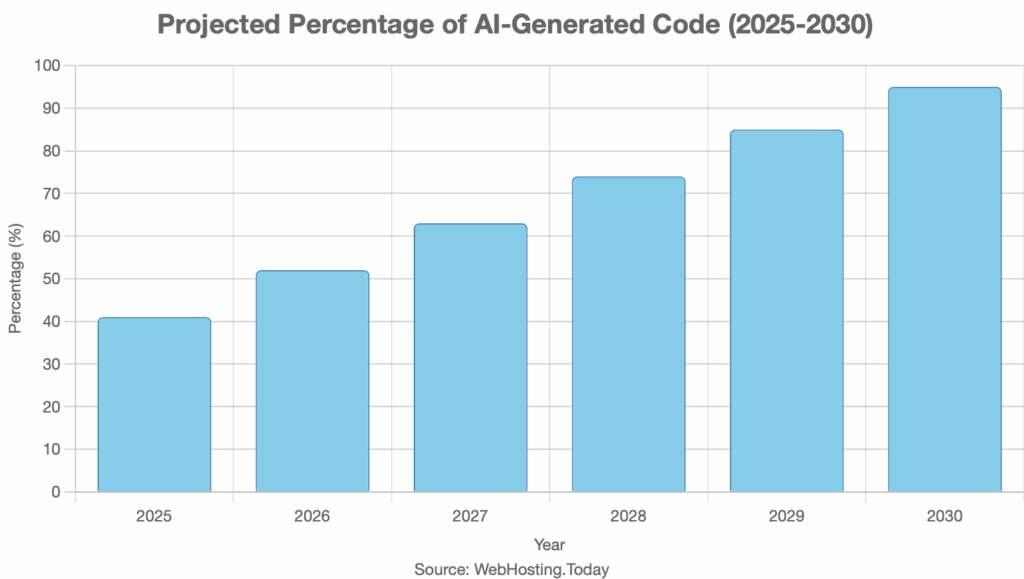There’s a quiet revolution happening in software development, and it’s not about the latest framework, it’s vibe coding, and it’s changing the way Applications and SaaS products are engineered. Introduced by AI pioneer Andrej Karpathy in early 2025, the idea invites developers and non-developers to state what they want in plain language, without code or syntax, just through prompts, and AI turns the vision into live software.
The spark behind vibe coding is the latest generation of large language models (LLMs). In record time they can architect, deploy, and sometimes scale whole applications. This isn’t a clever trick; it’s a substantial move toward democratizing technology. A well-crafted prompt can generate prototypes, lay out back-end systems, or test product ideas, usually within minutes to hours. That speed and openness are rewriting the playbooks for solo founders, weekend hackers, and Fortune 500 teams.

Key statistics on vibe coding and related AI-assisted coding:
- Searches for “vibe coding” surged by 6,700% in the three months leading up to July 2025, reflecting its rapid rise in popularity.
- As of 2023, 44% of developers had adopted AI coding tools, a figure likely higher now given the growth in vibe coding adoption.
- Over 25% of Y Combinator startups in 2025 rely on AI for 95% of their codebase, highlighting vibe coding’s impact on early-stage tech companies.
- 82% of developers use AI coding tools daily, with 78% reporting major productivity gains.
- The global market for AI code tools, which enable vibe coding, is projected to reach $27.17 billion by 2032.
- In a survey of professionals, 50% of less experienced coders see vibe coding as useful for niche applications, compared to 30% of senior professionals.
A New Skill for a New Era
What’s especially thrilling right now is that mastering prompts is emerging as both a sought-after craft and an easily teachable competency. We’re witnessing the emergence of a new literacy: prompt literacy. Your success now hinges on how clearly and strategically you can dialogue with the AI. Tools like PromptKit.io are lowering the entry barrier. Community-curated frameworks and no-code cheat sheets guide absolute beginners from their first queries to intricate workflows and app logic. This tightly knit ecosystem levels the playing field for newcomers and simultaneously supercharges the output of veteran developers.
Platforms Fueling the Movement
The support network for Vibe coding is already impressive. Services like Base44.com and Loveable.dev allow you to type out a bare idea and receive a fully functional application in return. Just Lovable.dev alone has launched 10 million projects, including both apps and prototypes, have been created on the platform, according to TechCrunch. There’s no fluff; these are live systems complete with user authentication, database hooks, email and SMS pipelines, and even elegant, managed hosting. Supabase seamlessly integrates as the silent powerhouse for many of these vibe-coded projects. You get real-time subscriptions, a PostgreSQL database, file storage, and vector embeddings, not a point-and-click AI maker, but the solid undercarriage that lets AI-generated solutions drive smoothly on the web.
Why AI Builders Need Better Hosting
There’s a hitch, though. Once these ideas evolve into full-blown products, they quickly stretch the limits of their starting platforms. Sandbox hosting is great for prototypes and show-off moments, but the instant a product attracts users, gathers live data, or suddenly needs compliance, the clock starts ticking for a move. Enter the traditional hosting providers; the rise of Vibe Coding is the flare shot into the night, an entirely fresh wave of creators is about to break, and they’re going to want the infrastructure to match their ambitions.
From Migration to Monetization
The scale of this chance is staggering, but it’s only captureable if the hosting players do their homework on this new crowd. Folks leaving Base44 or Loveable won’t tolerate arcane YAML files or 4,000-word setup manuals. They want a brightly colored button that elevates the entire app, and they want to transition to the next provider seamlessly. Whoever ships one-click migrations, identifies AI-crafted blueprints, and assembles the right environment on the fly is the provider that moves to the front of the pack.
Ease of use is just one piece of the puzzle. AI-written code carries its own baggage. Sure, some snippets are clean, but others trip over efficiency and security. Forward-thinking hosters can leverage this by layering on performance reviews, automated vulnerability scans, and LLM-driven code reviews. Picture a plan that flags tangled dependencies, suggests refactorings, and gives a heads-up on configuration landmines. That’s the shiny extra that makes the invoice feel justified.
Then there’s the roller coaster of scale. A Vibe codebase can hover silently for a month, then suddenly light up the charts. Providers that ship variable scaling, proactive traffic modeling, and resource knobs tuned for LLM workloads will catch the eye of creators who can’t afford surprises but also can’t afford overages. Toss in GPU punch, live performance insights, and intelligent edge cache, and a weekend hobbyist graduates to a die-hard subscriber.
The Goldmine Is Already Paying Out
The only remaining argument isn’t whether vibe coding will saturate the market; it already is. The only pressing question is who will siphon the overflow when thousands of polished, micro-apps evolve into full-scale products. Hosting companies now have a shrinking window to establish themselves as undisputed, essential providers in this next chapter. Streamline migrations, auto-tune resource scaling, and build support that rallies around the community, and watch the infrastructure lock in.
This is not a short-lived fad. We are witnessing a pipeline of innovation lock into place, transporting ideas from palm to deployed browser with a velocity that rewrites the timeline. Hosts that choose to role-shift now will discover the next goldrush has already begun.
Jason Nickerson
With over 20 years of experience building and shaping the web, Jason Nickerson has worked across just about every corner of the industry. Jason’s career has mirrored the internet’s evolution — from the recovery after the .com crash to the open-source movement and the rise of cloud services that power the web today.
